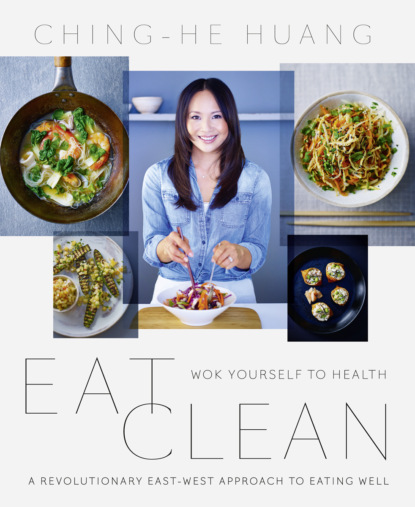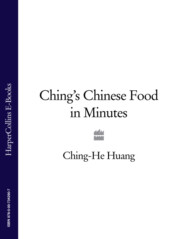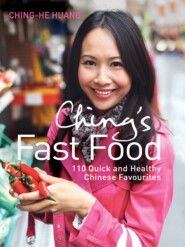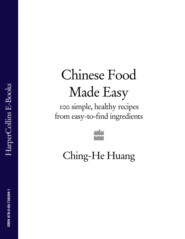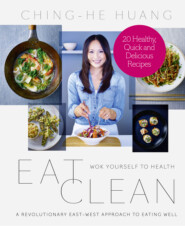По всем вопросам обращайтесь на: info@litportal.ru
(©) 2003-2024.
✖
Eat Clean: Wok Yourself to Health
Автор
Год написания книги
2019
Настройки чтения
Размер шрифта
Высота строк
Поля
There are many different approaches to diet and dieting. Some people suffer terrible allergies to specific foods and therefore have to eliminate certain ingredients from their diet – for example, nuts, shellfish, meat or dairy. Some people have so many problems that they need a drastic overhaul of their diet and so turn to raw veganism, and some are pescatarians. I believe there is no need for drastic measures but rather for a balanced way of eating that combines a little bit of everything, that contains the highest amounts of Yíngyǎng and ‘clean’ ingredients. Here are a few simple truths – and some of them might even challenge your pre-conceived ideas of optimum nutrition and health!
Did You Know?
1 Juicing is a good way to get a large hit of the vitamins you need in a handy glass, but it contains little fibre. Be aware of smoothies and juices: they can spike your insulin levels, as you are basically drinking liquid sugar. Instead, eat five portions of vegetables a day and limit yourself to one portion of fruit at any one time. It is worth noting that eating fruit as part of a meal will stop the sugar from being absorbed so quickly. Or choose low-GI (glycemic index – see here (#ulink_c173a062-e26b-58f1-951f-127953d95c6f)) fruits such as apples).
2 If you do juice, don’t just juice fruit, juice vegetables as well – for example, broccoli, kale and cabbage, with lime or lemon juice. Be sure to buy organic fruit and vegetables (or grow your own), otherwise you are drinking juice plus pesticides.
3 If you can stomach eating the peel and seeds of fruit such as oranges and lemons, do chew well. Papaya seeds are known to be healthful cures against parasites and harmful bacteria. You can grind these and add them to shakes or porridge. These are nature’s natural detox cleansing pills. Consult a herbalist, as some fruit seeds can contain toxins, but from my own experience, fresh seeds from grapefruit, lemons, oranges and papaya seeds are OK. Of course, dried seeds from watermelons, pumpkin and sunflowers are all good nutritional mineral sources, too.
4 Traditional Chinese medicine (similar to Indian Ayurveda) advises that you should eat the five tastes every day – sweet, salty, bitter, spicy and sour. Bitter is perhaps the hardest to take in daily, but teas and spices deliver on this. It is most important to look for natural ingredients, such as wholefoods, that contain these tastes.
5 Be aware of too many soy products. Buy organic or non-genetically modified sources of soy. Some studies have proved that soy can lower testosterone, block essential minerals from being absorbed and cause gastro-intestinal problems.
The Chinese philosophy states the 7 daily essentials: firewood (as a heat source), tea, rice, oil, salt, vinegar and sauce (natural fermented pastes that contain healthful bacteria). Oil and salt are good for you as long as they are from natural and ‘clean’ sources – free from as many pesticides and chemicals as possible. Salt should be from mineral-rich sources such as rock salt or sea salt, although conventional medicine would recommend avoiding added-salt and high-salt foods. Generally, our modern diets mean we consume more salt than we should.
6 Sweat – go to a sauna once a week and drink plenty of water. All the toxins collect around our cells and one way to help expel them is to exercise and sweat. Our skin is the largest detox organ found in our bodies and we never think to make full use of it. We think of sweating as gross and do all sorts to block sweat, but we are hindering our body from working at its optimum level. Anti-perspirants are full of chemicals that are absorbed directly into the body. If you are sweaty, then sweat! It is the body’s way of clearing the toxins.
7 Drink more water, especially in the morning. Drinking water on an empty stomach helps to cleanse the colon and gut, thereby increasing its ability to absorb nutrients. It also helps prevent constipation, increases the production of new blood and muscle cells, helps with weight loss and can boost the metabolism. Chinese dietary practices believe that water should be drunk at room temperature or body temperature, which is 37.5ºC. Ice-cold water can ‘shock’ the stomach into inactivity. Drinking water helps improve the skin, gets rid of toxins from the blood and keeps your skin clear and glowing. Keeping hydrated also balances your lymph system, which helps perform daily functions like fight infection. Water also helps your skin look plump and youthful, so you stay looking younger for longer. And who doesn’t want that? Just make sure you buy a good filter to filter out any pollutants or chemicals found in tap water.
Clean Eating = Good Health = Lean and Slim
If you have picked up this book in the hope of getting lean, then unsurprisingly the answer is clean, consistent eating. Consistently choosing the right foods over time WILL deliver results. This is hardly a revolutionary idea. However, the clean recipes in this book are so easy to cook and taste great that it makes being consistent that much easier.
If you are currently at a body weight you are unhappy with, it’s important to recognise that you did not get that way overnight. It was most likely gradually crept up on you. The same goes for losing weight – it’s a slow journey that takes time. Consistent actions will produce lasting results.
Weight loss is not about starving yourself but rather about feeding your body with all the precious, essential nutrients that will help build the body of our dreams: by looking good, we feel great and by feeling great, we look good. This is the balance of yin and yang (light and dark), energy and matter, body and mind, soul and spirit, conscious and unconscious.
Eating to sustain the body is crucial for our well-being, but we have lost our way and people now eat ‘emotionally’ to fill a void. When we eat to fill an emotion, it often leads to disaster! We make poor choices and we don’t eat to fill the body with nutrients, and often we put more stress on it by eating the wrong foods. This balance needs to be tipped as obesity numbers are rising faster than ever.
The world works in perfect unity – from warm to hot to mild to cold. Just as our planet needs our love and care, our body is our world and its ecosystem is regulated by how much we nurture it with love and nutrients. This connection between all things and all emotions is the key to what you desire.
This mindset is important, because the desire to achieve your full potential will drive you to understand nutrition and to learn how to cook and eat so that you can get those results. Having this knowledge will empower you to make positive changes to your diet.
So every time you reach for something to eat, ask yourself if you are truly hungry. And question why you are eating. This is the first step to being honest with yourself and fully aware of your habits so that you can avoid emotional eating and therefore overeating! Keeping a diary, being on track of what you eat, is not an obsessive thing to do – in fact, it is an obsession we should keep. Our bodies have to function every day for the rest of our lives, so why shouldn’t we be obsessive about keeping them strong and healthy?
The Science Behind Our Food
Macro-nutrients
The foods that we eat are primarily comprised of three different macro-nutrients. These are fats, proteins and carbohydrates. We need a balance of all these nutrients in order to have good health.
Fats
Although fats have got a bad name in the past, it is now clear that they are very important for humans to maintain good health and metabolic function. It’s more about the kind of fats that you are consuming.
Monounsaturated fats and polyunsaturated fats are better for you. These are usually liquid at room temperature and when eaten in moderation reduce blood cholesterol and thus diminish the chance of heart disease. Omega-3 fatty acids are a type of polyunsaturated fat and are extremely good for heart health. The best source of omega-3 fats is oily fish; some plant foods such as walnuts, flaxseeds and their oils also contain some.
Try to stay away from saturated fats from animal sources, as these raise cholesterol and increase the risk of heart disease. However, saturated fats from plant sources, such as coconut oil, may not have this problem and some experts believe they may actually contribute towards heart health. Trans fats or hydrogenated fats are also ones to avoid. These are oils that have had hydrogen chemically added to them. These fats cause a rise in cholesterol and significantly increase the risk of heart disease.
Protein
Protein is vital for the growth and repair of muscle, ligaments and tendons, DNA replication and cell regeneration.
Proteins are made up from chains of amino acids. These can be non-essential amino acids, meaning that the body can manufacture them itself, or essential amino acids, meaning that the body cannot synthesise them and they must therefore be consumed from food. There are nine essential amino acids, and proteins containing all nine are called ‘complete’. Those that don’t contain all nine are thus termed ‘incomplete’.
There are abundant sources of complete protein in meat, eggs, fish, dairy and quinoa. Protein is also found in beans and grains, and although they are classed as incomplete, two or more groups of these foods (for example, black beans and rice) can be combined to create a complete array of amino acids.
Carbohydrates
Carbohydrates are used as a primary energy source within our bodies. Sugars and starches are both made from sugar molecules, and after these enter the bloodstream, insulin takes the sugar into the body’s cells (including the brain, liver and muscles) to provide energy or fuel for the body. If there is an excess, it is stored as fat.
When we eat simple carbs, our bloodstream is flooded with sugar due to this simple chemical structure being digested quickly. The body cannot deal with this sudden rise in blood sugar, so the body processes it quicker by releasing insulin, and any excess sugar not used immediately by the body as fuel is stored as fat.
Complex carbs or starches, on the other hand, are comprised of many sugar molecules joined together in long chains and are usually found in wholefood sources such as sweet potato. These long chains take much longer to be digested and therefore release energy slowly over a period of hours. This gradual release does not greatly spike insulin levels and therefore doesn’t trigger fat storage. These carbs tend to have a much lower rating on the glycemic index (GI). The glycemic index is a system of rating how fast carbohydrates are converted into glucose in the body. The higher the GI number, the faster the glucose levels rise in the body. Another benefit of eating complex carbs is that they usually come with lots of fibre, too. Fibre will make you feel full, so that you are more satisfied and therefore less likely to over-eat unhealthy foods. It also keeps your digestive system working correctly and can help to lower cholesterol.
It will come as no surprise, then, that I advocate sticking to carbohydrates from complex sources as much as possible, as it will help you become heathier and leaner. In fact, if you never consumed a simple carbohydrate during your whole life you would be just fine! One exception to this is eating fruit. Fruit contains fructose which, even though it is a simple sugar, does not have a high impact on blood sugar levels due to its fibre content and because it is metabolised differently in the body. However, eating too much fruit, like anything else, will lead to weight gain, so consume in moderation. It’s also best to try to avoid any processed food containing fructose as a sweetener as it is extremely concentrated and goes straight into the liver, which can cause toxicity.
Tracking macros
An extremely useful tool for anyone wanting to get lean is to track your macro-nutrients (carbohydrates, fats and proteins). The premise is that to gain or lose weight you need to consume a certain number of calories every day. These calories are made up from carbohydrates, fats and proteins in differing amounts. By tracking them, you can see how much of each you are consuming daily and easily hit your target for each macro.
There are lots of macro-nutrient calculators online that will tell you how much of each macro-nutrient you should be consuming per day based on your goal, height, weight, sex and activity level. These are useful as a starting point but everybody is different, so it requires some trial and error to find out which amounts make you lose/gain weight. Keeping a daily record allows you to figure out how many calories you need to consume to lose weight and what those calories should come from.
Although this approach requires some effort, it is well worth trying. Logging your food is easier then ever – I can recommend this online calculator as a good starting point: www.healthyeater.com/flexible-dieting-calculator. Or if you have a smart phone, Calorie Count is a very handy app to track your macros. Tracking macros also has the benefit of reducing hunger pangs greatly. This is because when focused on hitting the macro targets people tend to eat more regularly, are less hungry between meals, and thus avoid snacking. The result of this is that for most of the day you are full up with healthy food and junk food cravings are greatly diminished.
All of the recipes in the book have both the total calories and the macro-nutrient breakdown to make it easy for anyone following this approach.
A deeper connection through choice – choose clean eating, choose health
This book was born out of my desire to eat and live better. I was creating recipes as a chef and thought my food was healthy, but I wanted to really know, have a deeper understanding of and monitor the nutrients that my body consumes. As I age, I want to be healthy and fit, I want to be in the best shape I can be. I want to enjoy food, eat well and I want to be aware of what I eat. While researching for this book, what I found was a revelation – that most ingredients in their pure unprocessed state are full of goodness. It’s not difficult to eat healthily, it’s about making healthful food choices, about being mindful in choosing to eat well. On the whole, our body is ingenious, here to protect and take care of us if we feed it the right nutrients to allow it to work efficiently. By feeding it the right fuels, maintaining one’s natural slim waistline without overly exercising is within reach.
I wanted to find a way to break all this down to serve as a reminder to help us to eat consciously. We can choose to be happy or healthy or both. It comes back to a state of mind. We can choose to be responsible for our lives and the environment we live in, or we can choose to be ignorant. There is no right or wrong, no judgements made; however, your choices reveal who you really are and who you want to be. Are you conscious or unconscious? Are you open- or closed-minded? Do you choose love or fear? Wellness or illness? This may seem rather extreme – and it is! But being true to yourself is the root of good emotional health and translates to good body health. Hence the term body, mind and spirit. Only you have yourself to answer to!
The future of food – a revolution in ‘thoughtful’ eating
My comparisons are extreme, but there is food for thought here. The world is overpopulated, yet if we really wanted to save our oceans and stop the killing of animals, we could – but we don’t. Could the world’s population stop eating fish for 10 years and wouldn’t fish stocks be restored? If we all stopped eating processed foods for 10 years and only ate a diet of wholefoods, wouldn’t we be in the best health of our lives? I don’t mean to be preachy. I think we should spend more time caring about what is truly important in life – food, water, love, care and respect for the environment. If we all cared and shared the same values as human beings, perhaps we would be one step closer to solving the world’s problems together. And what is more important than securing sustainable sources of healthful, pure, clean foods?
I do not have the answers to all questions, because I am on my own journey to understanding all the complexity that surrounds our current system. The world produces more food than ever before, yet we have more complex diseases than ever. This is rather worrying, as food is supposed to sustain us, not cause us illness! Our health depends on the cleanliness and health of our planet. We could all do with cleaning up our acts individually and collectively for future generations. For me, if this means sacrificing my palate, then so be it. I know I am not alone in this quest. Cultural beliefs and eating habits will ultimately change as we will fight together for change for survival.
A Cook’s Notes
• All recipes serve 1, unless otherwise stated.
• Use organic ingredients where possible.
• There are specific egg brands that are organic; the hens are fed a special diet, so have increased sources of omega 3. Look out for these as they have a higher nutrient content.
• I prefer to use a combination of organic coconut oil and rapeseed oil. For those wanting a lower calorie and fat content, substitute 1 tablespoon of coconut oil for half a tablespoon of rapeseed oil or 1 teaspoon of coconut oil with ½ teaspoon of rapeseed oil. This will reduce the amount of fat, saturated fat and calories.





